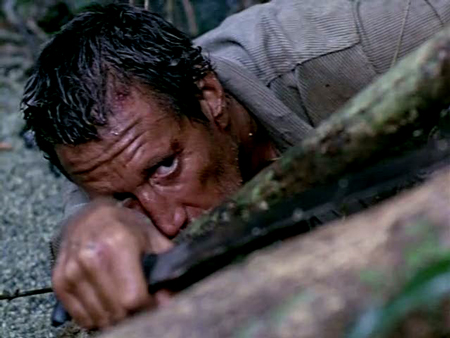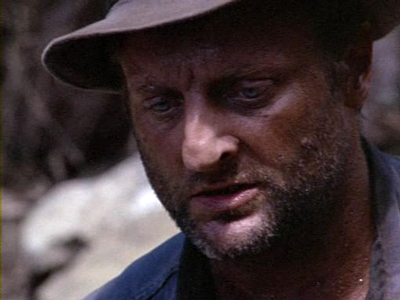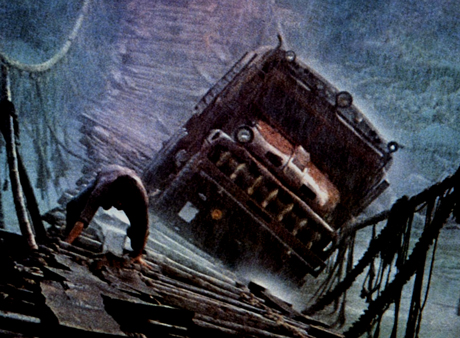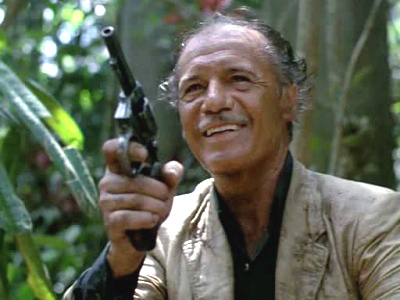Reviewed by Glenn Erickson
William Friedkin names 1977's Sorcerer as his favorite among his movies. That's possibly because he put so much blood and sweat into the show, with a grueling, disaster-plagued shoot in the Dominican Republic and Mexico, as well as Israel, Paris, New Jersey and New Mexico. Impressed by Henri-Georges Clouzot's classic The Wages of Fear, Friedkin embarked on a costly remake. In many ways it's a beautiful show, but it lacks the director's double-whammy of powerful filmmaking plus incredibly lucky timing. When his The French Connection became a hit in 1971, audiences were seemingly primed for a gritty & profane cop show with thrilling action scenes. In addition to its brilliant marketing campaign, 1973's The Exorcist showed Friedkin willing to pull out all the stops for a horror story that literally brutalized the audience.

Commercially speaking, Sorcerer had big problems. The title led everyone to believe it had something to do with the supernatural, like his previous film. Roy Scheider was the only known actor in Friedkin's excellent cast. Unrelentingly dark and pessimistic, the movie arrived in the wake of the big Spring release Star Wars, when no other film seemed to exist. As Friedkin himself explains, Sorcerer played exactly one week at Mann's Chinese before being dropped in favor of a return of George Lucas's film. 3
Most critics clobbered Sorcerer as a complete misfire. I saw it on Independence Day (in a packed Westwood theater, I must say) and felt unfulfilled by Friedkin's suspense-challenged narrative and humorless characters. But how does it play today?
Friedkin and his screenwriter Walon Green open up Georges Arnaud's novel La salaire de peur by showing how four men came to flee their home countries and end up trapped in a South American oil outpost. Paid assassin Nilo (Francisco Rabal) and Palestinian bomber Kassem (Amidou) flee retribution for their crimes. Caught embezzling funds, French gentleman Victor Manzon (Bruno Cremer) runs to escape public humiliation and a long prison sentence. Finally, getaway driver Jackie Scanlon (Roy Schieder) takes his one-way trip to nowhere after a botched robbery of Mob money in New Jersey.

As in the Clouzot movie, these four and many other foreigners are struck in a wretched shack town outside an oil company outpost in a South American dictatorship. They haven't enough money to leave the isolated location and can't get jobs. They also lack legitimate passports. Their chance comes when rebels blow up an oil well, which must be extinguished with high explosives. The only supplies are too volatile to move by legal means, so the oil company manager Corlette (Ramon Bieri) puts out a call for experienced drivers to transport the unstable cargo 218 miles over ridiculously rugged roads. Three of our renegades make the cut, and the fourth earns his spot through murder. Yet the job is a suicide mission: the oil company is sending two trucks in the belief that at least one won't make it.
Sorcerer looks great and contains impressive action scenes. The first time I saw the traffic accident in New Jersey I was genuinely jolted. The riot over the burned corpses in the village is also pretty strong stuff; in 1975 it seemed shockingly obvious that the mob would direct its anger at the innocent soldiers and truck drivers. In many ways Friedkin's jungle trek improves on the first film. The rain-soaked tropical locations are more realistic than the dry mountains in the South of France (?) where Clouzot filmed. The four men endure a worse trip in this picture, that's for sure.
The most remarkable scene is of course the near-absurd river crossing on a wind-tossed cable bridge that barely has enough wood remaining to support the trucks. The trucks inch their way across, splintering what support planks still remain and at times tilting dangerously. Friedkin judges this scene beautifully. It looks so real that we believe it could actually be done... well, we believe it long enough for the scene to work. Friedkin can be praised for sticking to his 'vision': the crew tried for weeks to make the scene work in the Dominican Republic, and then had to start over in Mexico. Sorcerer ended up so costly that Friedkin knew it would have to be a big success not to cripple his directing career.

On this truly handsome Blu-ray Sorcerer is a pleasure to watch just for its audacity and spectacular set pieces. But as a fully realized entertainment it misses the mark. Friedkin insists that the show is not a remake, yet it obviously is. The story particulars and what happens to the characters are largely the same. Friedkin and writer Green succeed in making their characters unlikeable, but the actors seem to be fighting that effort. We have naturally positive feelings toward Roy Scheider's Scanlon, even when he roots for the other truck to blow up, so that his take-home salary will double. 1 Likewise, we want to like the other three crooks- turned suicide drivers. The terrorist bomber's expertise with explosives comes in handy at one point, and even the loathsome assassin Nilo has the right skill for the moment when he and Scanlon are waylaid by murderous bandits. In an action movie, professional skills are always something to admire.
Friedkin refuses to give any of his adventurers a sense of humor. He apparently doesn't want to dampen the tension, but little tension develops if we can't identify with the characters enough to invest in their survival. That doesn't happen here. Friedkin concentrates on his precise angles and cutting, and short-changes the human factor. Because Sorcerer is so much like The Wages of Fear we can't help noticing that nothing that happens is as tense as in the first film. The people are credible but very thin -- in the final couple of scenes Scanlon and Nilo's acting seems to be provided by a makeup job that gives their faces a blood-drained ghost quality. Friedkin's spooky mood and cynical throwaway finish fall very flat. We admire Sorcerer but aren't particularly engaged by it. 2
Roy Scheider is well cast but isn't given enough to build a full screen personality for Scanlon. Bruno Cremer should have been a bigger star, as he's excellent; he has a tough face that would have looked great in a Melville-style crime picture. Here Cremer at least gets to show what he's lost with his expressive eyes: a chateau, a fancy wife, fine cuisine. Amidou is the film's concession to youth, even though he was 41 at the time of filming. When his Kassem almost falls through the cable bridge, we think that he might get run over, just like Charles Vanel in the original.

Francisco Rabal's ruthless hired killer is the most mysterious and least probed character, the one who breaks down in fear yet marshals his killer instincts to save the day for Scanlon. Friedkin wanted Rabal to play Frog One in The French Connection but was saved by a providential screw-up: he confused Rabal with his fellow Spanish actor Fernando Rey, who got the part. Rey's magical performance opposite Gene Hackman provided the chemistry that made French Connection connect big-time with audiences. In Sorcerer no such chemistry is permitted.
Less important but still relevant is the fact that Friedkin's remake lacks the original's sense of political outrage, and replaces it with a dull pessimism. The original film carries a fierce anger against an economic system that dispossesses the Third World and places profits above human lives. The Sorcerer just accepts those conditions as a given. 'Terrorists' get the blame for the oil disaster.
Viewers may not know what a great actor Francisco Rabal was. A favorite of Luis Buñuel, he played his share of weird creeps but also embodied the movies' most interesting religious figure, Nazarín. He played Che Guevara and Francisco Goya (twice), and was also the perverted Euro-horror movie director Máximo Espejo in Pedro Almodóvar's ¡Átame! (Tie Me Up! Tie Me Down!).
Sorcerer is yet another Blu-ray release of this year to carry a music score by Tangerine Dream. In this regard William Friedkin displayed a good ear -- 1977 was before Thief, Dead Kids and Risky Business.
Warner Home Video's Blu-ray of Sorcerer is a stunning transfer, with 5.1 audio, of William Friedkin's impressive production. After years of low-grade video presentations the color and sharpness of this encoding really stick out. Only one shot seemed bogus, an aerial angle of the jungle in which the greenery leaps out with a blast of oversaturated chroma. But Friedkin hasn't indulged in any color experiments and the transfer overall is stunning. The bridge sequence in particular looks terrific, half obscured by curtains of pouring rain. It's unforgettable.
There are no video extras on this presentation. In the fancy illustrated color souvenir book packaging we instead get an adapted chapter on the making of the picture from Friedkin's book The Friedkin Connection. The director gives an exciting account of the perils of the shoot. From editing the extras for To Live and Die in L.A., I remember hearing that editor and co-producer Bud S. Smith amassed a wealth of film materials from the shoot for the express purpose of making a Burden of Dreams- style documentary, or at least a long-form featurette. If Sorcerer had been considered a bigger picture, it might have been possible for such a show to be made.
On a scale of Excellent, Good, Fair, and Poor,
Sorcerer Blu-ray rates:
Movie: Very Good
Video: Excellent
Sound: Excellent
Supplements: color illustrated souvenir book with William Friedkin essay.
Deaf and Hearing-impaired Friendly?
YES; Subtitles: English, Spanish, French
Packaging: 1 Blu-ray disc in plastic holder in book-style packaging
Reviewed: April 19, 2014
Republished by permission of World Cinema Paradise.
Footnotes:
1. Director Robert Aldrich and Hammer Films completely blew their seemingly bullet-proof bomb disposal movie Ten Seconds to Hell. The excellent story idea included the same gimmick: the fewer team members that survive, the more each will earn.
Return
2. Friedkin liked to dazzle interviewers with radical filmmaking statements. He once said that he purposely cut short the finish of Sorcerer's rickety bridge scene because he had decided that the way to maintain audience tension at a peak pitch was not to give nerve-rattling scenes a calming resolution. That's why the bridge crossing ends with a bizarre cutaway the very moment that the second truck's tires reach safety. Some theory -- the cut is so ragged that it looks like the film broke, or that something was censored.
In The Exorcist Friedkin's relentlessly mechanical strategy was much more successful. He alternates LOUD horrific scenes with calm quiet ones. Friedkin was basically hitting his audience with a cinematic sledgehammer in The Exorcist. He cleverly decided that his masochistic ticket buyers needed a break between hammer blows to retch and recover.
Return
3. A corrective note from "B", 5/10/14:
Dear Glenn: Almost everything you say about this fascinating, hard-to-forget fallen souffle of a movie is on-target. ["Dramatically inert" may be a little generous, though.]
"As Friedkin himself explains, Sorcerer played exactly one week at Mann's Chinese before being dropped in favor of a return of George Lucas's film."
Take little this gentleman says at face value. If memory serves -- and this must be checkable -- Sorcerer opened at the Chinese on June 24, 1977, replacing Star Wars, which had opened to smash out-of-the-gate business on May 25. [The original booking at the Chinese for the Lucas picture came only when the planned-May opening of Friedkin's film, long committed to play at the theatre, was delayed because the movie wasn't quite ready.] The Friedkin picture, which Paramount and Universal hoped and perhaps assumed would play at the Chinese for many months, was not met with much enthusiasm, but it did wanly hang on at the place for about five weeks; this was almost certainly a contractual obligation for the exhibitor. In early August, Star Wars triumphantly returned to the house. It played at the Chinese until June of '78. Best, Always. -- B.
Return

Text © Copyright 2014 Glenn Erickson
See more exclusive reviews on the Savant Main Page.
The version of this review on the Savant main site has additional images, footnotes and credits information, and may be updated and annotated with reader input and graphics.
Return to Top of Page
|

